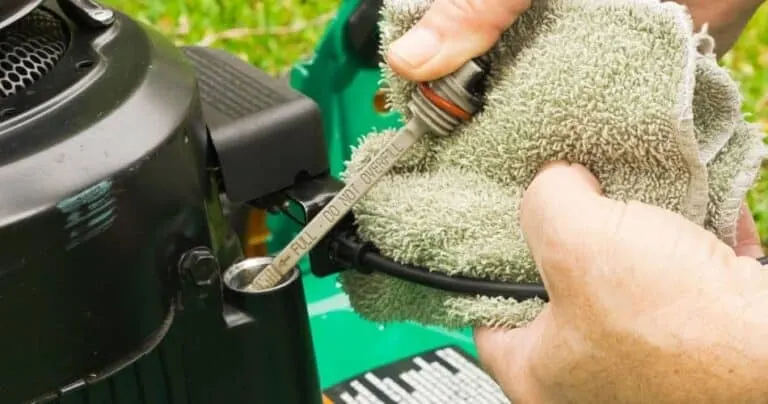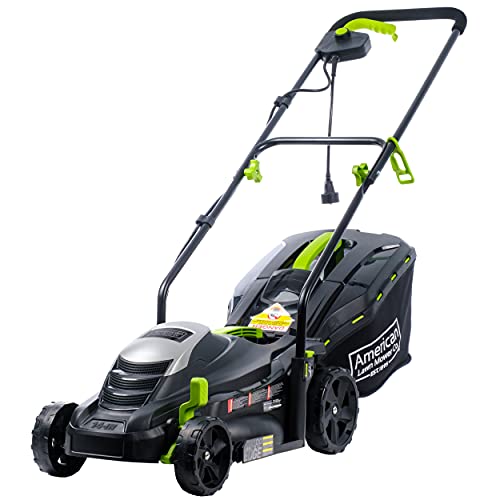If you’ve noticed your lawn mower emitting white smoke or running rough, it could be the result of having too much oil in the engine.
Overfilling with oil can lead to serious damage and performance issues. To address this problem, you should drain the excess oil from the drain plug, the oil filter, and the fill hole.
If you’re not confident in doing it yourself, seeking professional assistance from a small engine mechanic is recommended.
But if you are up to the task, read on. Below, we explain how to remove the excess oil. We also present the signs your mower has too much oil and list the negative effect it may have on its performance.
Let’s jump right into it.
Signs Your Lawn Mower Has Too Much Oil
The best way to identify problems with your lawn mower is to pay attention to certain telltale signs. For instance, a symptom like an extremely hot or overheating engine might suggest a problem with your cooling system.
On the other hand, blue or white smoke emitting from your vehicle might indicate oil is burning within the exhaust area. It is an immediate red flag for possible engine troubles and should not be ignored.
These seemingly trivial problems can take a toll on your vehicle’s engine health in the long run. Therefore, don’t overlook these symptoms and ensure regular car maintenance for a smooth and trouble-free ride.
Here’s a list of problems to look out for:
- A hard start of the motor is a common sign of too much oil. When there’s an overload of oil in the engine, certain parts come into contact with motor oil that they shouldn’t. It can make it difficult for the motor to start smoothly.
- Leaking oil is another symptom you should look out for. The excess lubricant can escape from different areas of the machine, such as the muffler or exhaust. This leakage can be messy and potentially damage other components if not addressed promptly.
- If you notice oil in the carburetor when tipping your mower at an angle or trimming on hilly terrain, it could stem from too much oil in your lawn mower. In such a case, the surplus lubricant flows toward the carburetor instead of staying within its designated areas.
- White smoke emitting from the muffler is another sign that your lawn mower has excess oil. This symptom often occurs alongside visible droplets of oil coming from the muffler.
- Lastly, if you notice droplets on an air filter, it’s also a sign there’s too much lubricant circulating through your lawn mower’s system.
Negative Effects on Performance
When you overfill the oil in your lawn mower, it may cause numerous issues. For example, excess oil can result in engine overheating, which can damage the internal components of your mower.
Another negative effect is the potential for hydro-lock, where the excess oil fills up the combustion chamber and prevents proper piston movement.
Let’s take a closer look at the most commonly encountered issues caused by overfilling your mower.
Engine Seal Damage
Too much oil in the crankcase can create excessive pressure that puts strain on the engine seals. Over time, this increased pressure might cause the seals to fail, leading to leaks and other problems.
Eventually, it can decrease the performance of your mower and lead to expensive repairs.
The table below presents just a few of the issues you may encounter.
| Potential Issues | Needed Repairs |
| Oil leakage | Seal replacement |
| Decreased performance | Engine rebuild |
| Friction and wear | Component replacement |
Engine Overheating
Adding too much oil can also disrupt the cooling process. It may result in increased friction and heat buildup within the engine.
Here are four symptoms of engine overheating caused by too much oil:
- Increased temperature gauge reading: The temperature gauge on your lawn mower may show higher than regular readings, indicating the engine is running hotter than it should.
- Smoke from the engine: Excess oil can cause smoke to emit from the muffler or other areas of the engine due to burning oil.
- Engine performance issues: Overheating can lead to a decrease in power and poor performance of your lawn mower.
- Engine shutdown: In severe cases, the excessive heat generated by too much oil can cause your engine to shut down completely.
Hydro-Lock
A severe overfill of the oil tank can lead to a hydro-lock, where excess oil fills the combustion chamber and prevents the piston from moving. As a result, the engine might start stalling and be unable to restart.
In multi-cylinder mowers, attempting to crank the engine when hydro-locked could even bend the con rods. It can cause irreparable damage, leaving you frustrated and without a working mower.
Blown Gasket
A blown gasket can be another costly consequence of overfilling the oil in your lawn mower engine.
This problem is even more significant in twin-cylinder engines, as it may require removing the entire engine from the mower for repairs, leading to additional labor costs.
To avoid blown gaskets, follow the manufacturer’s guidelines for oil capacity and only add the recommended amount. Adding a little extra oil may seem harmless, but it can have severe consequences.
If you suspect you’ve overfilled your lawn mower with oil and are experiencing symptoms such as leaking oil or poor engine performance, address the issue as soon as possible.
Lawn Mower Smoking

Finally, excess oil in your lawn mower can turn it into a smoke machine.
When there’s too much oil in the engine, it can find its way into the valve train and get burned in the cylinder. This situation leads to the emission of whitish-blue stinky smoke.
As the engine pulls in crankcase air and oil instead of clean air, the air filter can also become clogged.
Here are five symptoms of a smoking lawn mower due to excess oil:
- Thick clouds of white or blue smoke coming from the exhaust,
- A strong smell of burning oil,
- Reduced engine performance and power,
- Clogged or dirty air filter,
- Fouled spark plugs.
Removing Excess Oil
Follow these steps to effectively resolve the issue of excess oil in your lawn mower:
- Begin by wiping the area around the crankcase with a clean cloth or rag to ensure no dirt enters the crankcase during the process.
- Then, unscrew the tube to drain all of the oil from the mower.
- It’s best to tilt the machine on its side. It prevents the oil from entering the carburetor and combustion chamber, which can cause difficulties starting the engine.
- Stay patient and allow all of the excess oil to drain into a capable oil container. It’s a good idea to place some newspapers under the container in case of oil spills.
- If any excess oil does make its way into other parts of your lawn mower, clean them thoroughly.
- Remember to dispose of drained oil properly in an environmentally safe manner.
- Once you have successfully removed all excess oil from your lawn mower, you can continue using it without worrying about the potential damage caused by overfilling.
Seeking Professional Assistance
If you’re unsure how to address the issue adequately, it’s best to seek professional assistance for your lawn mower. Tearing apart the engine without proper knowledge can lead to additional damage and potentially make the problem worse.
Finding a reputable small engine mechanic is crucial in this situation.
Your local full-service lawn mower dealership is a great place to start. They likely have knowledgeable technicians who specialize in lawn mower repairs and can inspect your engine to determine the extent of the damage caused by overfilling with oil.
Besides, they have access to manufacturer-specific resources and tools that may be needed for the repair.
Another option is to search for a small engine repair dealer specializing in the specific engine brand installed in your mower. These dealers are experienced with that particular engine type and will know how to fix any issues caused by overfilling with oil.
Proper Maintenance and Care

Taking proper care of your lawn mower is essential for maintaining its performance and longevity. A critical aspect of maintenance is using the correct amount and type of oil in your mower.
The exact volume of oil needed can vary depending on the type of mower and engine size. When in doubt, refer to the owner’s manual or manufacturer instructions to determine the specific oil capacity for your mower.
It’s also important to use the correct type of oil. Factors such as the type of mower, engine specifications, and outdoor temperature will influence which oil is best suited for your machine.
On top of that, regularly checking and changing the oil in your lawn mower is necessary to prevent issues caused by too much or too little oil.
Overfilling with oil can lead to various problems like engine damage, overheating, leaks, and poor performance.
Conversely, insufficient amounts of oil can cause inadequate lubrication and increased wear on engine components.
The Bottom Line
Overfilling the oil in your lawn mower is a mistake many people make. So, if you’ve found yourself in this situation, don’t be too hard on yourself.
The solution to this problem is simple and relatively inexpensive. Generally, it won’t cost you much more than purchasing a new can of oil.
Still, you shouldn’t ignore the signs of trouble, such as overheating, emitting blue or white smoke, or running rough.
You can quickly fix the problem by draining the excess oil.
To prevent overfilling in the future, refer to the owner’s manual for oil capacity and add oil gradually while checking the level each time.
Frequently Asked Questions
How can I tell if my lawn mower has too much oil?
To determine if your lawn mower has too much oil, use a dipstick and check if the oil level is between the full and add marks. Signs of excess oil include hard starting, leaks, slow starting motor, white smoke, and oil drops on the air filter.
What are the negative effects of having too much oil in my lawn mower?
Having too much oil in your lawn mower can lead to engine damage, overheating, blown gaskets, poor performance, and smoke. It’s essential to address this issue promptly to avoid further problems.
How do I remove excess oil from my lawn mower?
To remove excess oil from your lawn mower, follow these three steps:
- Start by cleaning the area around the crankcase.
- Unscrew the tube and tilt the mower to drain the oil.
- Replace the oil filter if necessary and dispose of the oil properly.
When should I seek professional assistance for my overfilled lawn mower?
You should seek professional assistance for your overfilled lawn mower if you are unsure how to fix the issue yourself. It is also a good idea to call in an expert if the excess oil has caused damage to other engine components.
What are some tips for properly maintaining and caring for my lawn mower to avoid overfilling with oil?
To properly maintain and care for your lawn mower, check the oil level regularly and refer to the instruction manual for the specific oil requirement. Fill gradually in small increments to avoid overfilling.
Was it helpful?

Enamored with the world of golf Jack pursued a degree in Golf Course Management at THE Ohio State University. This career path allowed him to work on some of the highest profile golf courses in the country! Due to the pandemic, Jack began Inside The Yard as a side hustle that quickly became his main hustle. Since starting the company, Jack has relocated to a homestead in Central Arkansas where he and his wife raise cattle and two little girls.






